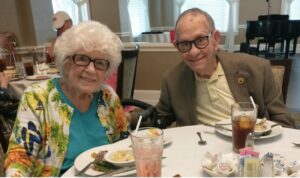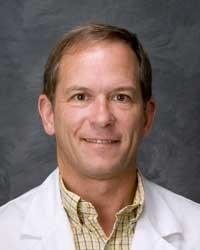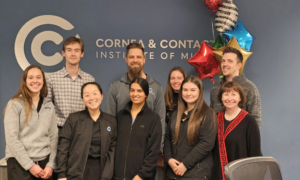
Dr. DeLoach’s parents, Marialyce and Dill. Dr. Deloach says doctors should rethink how they approach caring for patients over their lifetime.
Research findings to consider as we manage our patients—and ourselves.
By Joe DeLoach, OD, FAAO
Jan. 24, 2024
Why do we get old? Is dying of “natural causes” really natural? How young is “dying young”? Can we continue to buy the theory that we really don’t know what causes most diseases? Is aging just natural or actually a disease process? If it’s not natural, can we alter the process of aging? Can we reverse it?
If this sounds like the ultimate science fiction movie, it is not! Scientists all over the world are looking for an answer – why do we get old and ultimately die? Not quacks, renowned scientists at MIT, Harvard Medical School, Salk Institute, Albert Einstein School of Medicine, UCLA Medical School, London College of Medicine…just to name a few. These are scientists who simply believe aging is a disease, with an identifiable cause that can be altered. And many believe they have some early answers – answers that have resulted in what is being called the Informational Theory of Aging. To understand this, we go back to how living cells work.
How Do Our Cells Work?
Every cell in our body has the capability to maintain perfect function, repair itself when something goes wrong and replace itself if catastrophically damaged. The inner cell, or genome, contains our genetic code, our DNA. We are “coded” for perfect, continual performance. Surrounding the genome is the epigenome, containing molecules we call sirtuins.
The sirtuins direct the function of the genome and regulate every body function – our blood pressure, our normal metabolism, our blood sugar, our immune response, repair of damaged tissue and repair of the DNA structure itself. Sirtuins work predominantly through our mitochondria. When our blood pressure goes up, specific sirtuins leave their position in the epigenome to transmit information to our DNA to make hypotensive compounds and direct vascular regulation to decrease our blood pressure.
When a DNA strand is damaged, sirtuins enter the genome to direct the repair, replacing and extending DNA telomeres. Once their work is done, the sirtuins return to specific positions in the epigenome, waiting for their next command. These cellular actions happen millions of times a minute, if not a second. The action is theoretically perfect, self-sustaining and unending.
So, Why Don’t We Maintain Perfect Health & Live Forever?
In the Informational Theory of Aging, sirtuins are assaulted by external forces causing them to not be able to communicate with and direct activity in the genome. The system may be perfect, but lifestyle, bad food, bad medicine, obesity, environmental toxins, pesticides, metabolic disruptors, inflammation, stress, radiation and other factors simply overpower the ability of the sirtuins to do their job. Some of these external factors, like toxic chemicals and radiation, can irreparably damage the DNA itself. Sirtuins lose their roadmap and cannot find their way back to the specific action sites in the genome. Perfect function becomes unregulated dysfunction with an end result of arthritis, osteoporosis, hypertension, dermatitis, cancer, diabetes, autoimmune disorders – the list goes on and on. Included in the proposed list – aging.
“Unfixable,” or unregulated, DNA continues to try to work for us, but becomes a death scavenger – a system out of control pumping out massive inflammatory mediators. The vicious cycle of massive inflammation creating more damage in the epigenome begins. Once this occurs, the only variables are differences in how much the body is insulted and how long it takes the system to stop working altogether – what we call death.
Scientists studying aging are focusing on fixing the body at the source by maintaining the viability of the epigenome/genome communication system. They have identified many sirtuins, but the main research has been conducted on five: NAD (nicotinamide adenine dinucleotide – often referred to as the “master sirtuin”); NMN (nicotinamide mononucleatide), resveratrol, metformin and rapamycin. All of these substances are naturally occurring – NAD and NMN are relatives of the B-vitamin family.
Other Articles to Explore
Resveratrol is a natural phytoalexin. Even metformin is actually a botanical derived from the French Lilac bush. NMN is possibly the most studied sirtuin, but articles are commonly proposing metformin’s therapeutic value in managing a host of disease processes. Some propose that the function of metformin at the cellular level as an active sirtuin is where its therapeutic value lies (not in simply decreasing blood glucose in diabetics).
Can We Can Extend Life?
There are two questions to consider: What is your lifespan (how long do you live) and what is your health-span (how many of those years do you live in near-perfect health)? Surveys reveal most people would love to live to a ripe old age well over 100 if they feel like they are still 50. The now-infamous studies from David A. Sinclair, A.O., Ph.D., show a doubling of healthy lifespans in mice treated with NMN. He and others have also shown reversal of disease – including mice with crushed optic nerves regaining normal sight function.
Of greatest interest is the treated mice remain completely healthy with no signs of aging until very close to their death, which occurs quite suddenly. What a way to go! Unapproved human studies have shown reversal of dementia, elimination of autoimmune disorders, gray hair returning to natural color, women in their sixties experiencing the return of normal menstrual cycles.
None of the researched sirtuins are approved for disease treatment, much less for slowing down aging, but there is a growing trend of people who are taking things into their own hands – human consumption of NMN, resveratrol and metformin is not uncommon (NAD and rapamycin are not stable compounds outside the body). It has also spawned a supply chain of fake NMN and ineffective formulations of supplements – a real buyer-beware situation.
How Should Healthcare—Including ODs—Approach Patient Care?
While this all may seem a bit “out there,” what can be more illogical than a healthcare system that focuses on preventing nothing and curing nothing? The current state of medicine is not health care, it is disease care, perpetuated and held hostage by the FDA, the pharmaceutical industry and much of traditional allopathic medical theory. Maybe accepting that most disease is the result of many choices we make that promote bad health – toxic food, environmental toxins, obesity, toxic medications with minimal effectivity, sedentary lifestyles – is just too “out there.”
Research on aging is definitely in its infancy, but the knowledge from aging research is growing at staggering rates. An excellent book on aging research has been published by Dr. Sinclair – “Lifespan.” Be ready to be shocked!
NOTE: Other than greater self-study and taking steps to promote better overall health, the author proposes no specific action or self-treatment based on the information in this article. In the growing age of individual research on healthcare, each individual must decide what they believe and how they treat their body.
 Joe DeLoach, OD, FAAO, is a Clinical Professor at the University of Houston College of Optometry and CEO of Practice Compliance Solutions. To contact: : joe@practicecompliancesolutions.com
Joe DeLoach, OD, FAAO, is a Clinical Professor at the University of Houston College of Optometry and CEO of Practice Compliance Solutions. To contact: : joe@practicecompliancesolutions.com



























